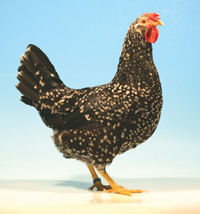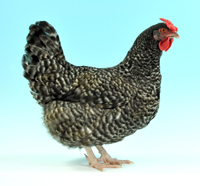Selection for Breeding Pure If the new poultry keeper intends to concentrate on serious conservation breeding and/or exhibiting it will be necessary to select parent stock very carefully. • Health: poultry which have suffered from any disease which has necessitated severe treatment should not be used for breeding. Good health is visible, it can be seen as well as felt when breeding stock is being selected. The feathers will be sleek, well furnished to form a protective covering during bad weather or hot sun. There will be a healthy glow about the head with no discoloration or weakness apparent. In most varieties, faces and wattles will be bright red, some are naturally dark. Discoloration or darkening of the red comb might indicate liver or heart trouble, or it might be obesity, so the correct diet is important. There should be no wheezing that indicates respiratory or heart trouble. The face should be open with a pleasant expression. Eyes should be bright and stand out well from the head, nostrils dry. Plumage should be normal for the breed with each feather wide, well made, whole and resilient. Tail furnishings should be plentiful according to the Standard. • Conformation: according to the breed the shape (type) of the bird is laid down in the Standard. Examine the legs and feet: bones should be sound, neat, toes straight and refined. No breed should have coarse shanks and thick scales. Texture will be shown in tight, well-fitting scales continuing down the toes. Any deformity such as bent toes, duck feet, crooked breast bone, wry tail or split wing should mean rejection as a breeder. • Breed character: all the poultry which have passed the handling test for health and conformation should be scrutinised for breed character. Because points vary for each breed it is necessary at this stage to know how many points are awarded for which shape, size or colour according to the different breeds, especially for show stock. • Colour: detailed official colour (and type) Standards for each breed are to be found in the British Poultry Standards (Wileys), overseen by The Poultry Club. Every breed has a Standard to which it must conform and every prospective breeding bird must carry good points of breed character and colour to accord with its breed name. • Head points: these are especially featured because few Standards exist which do not give a fair share of points to formation of comb, lobes and wattles. Close inspection is necessary. Breeds with small single combs will not readily show up defects in females but will be latent and recur in cockerels of the following generation. Thin, glossy skin is not wanted in white lobed breeds. It will soon yield to white in the face, a serious defect in showing and breeding. (hover over pictures for breed)
|






